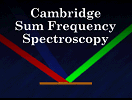|
|
|
Navigation Links |
||
| Home Page |
||
| Latest News |
||
| Group Members |
||
| Research Interests |
||
| Collaborations |
||
| Publications |
||
| Conferences |
||
| Contact Details |
||
| Gallery |
||
| Links |
||
Research InterestsTunable Far Infrared (TuFIR) Spectroscopy
|

|
||
|
Overview |
|||
Spectroscopy is the physical science which studies interactions between electromagnetic radiation, (i.e. light), and matter (e.g. atoms, molecules). As a fundamental scientific research field, spectroscopy enables one to determine the existence and structures of new molecular species, (e.g. the 1996 Nobel Prize for Chemistry was awarded for the discovery of C60 - the existence and structure of this molecule was determined by Mass Spectroscopy). This project applies high resolution, Tunable Far Infrared (TuFIR) Spectroscopy to the study of molecular species in the gas phase. Following its development in the 1980’s there are currently seven groups using TuFIR Spectroscopy world-wide; the Cambridge spectrometer is unique in the UK. |
|||
|
Applications |
|||
Free radicals are chemically reactive molecules which persist for very short times, i.e. they react with other molecules almost as quickly as they are formed. They are of particular importance in atmospheric chemistry and play a major role in the production of the Ozone Hole. In atmospheric cycles, free radicals are established as precursors, intermediates, and products of reactions. The most abundant of these radicals have been identified by low resolution, Far Infrared (FIR) Spectroscopy of the Earth’s stratosphere using satellite, aircraft and balloon borne spectrometers. There are two ways in which TuFIR Spectroscopy is applied in the laboratory to studies of atmospherically important radicals;
Return to Top of Page |
| ||